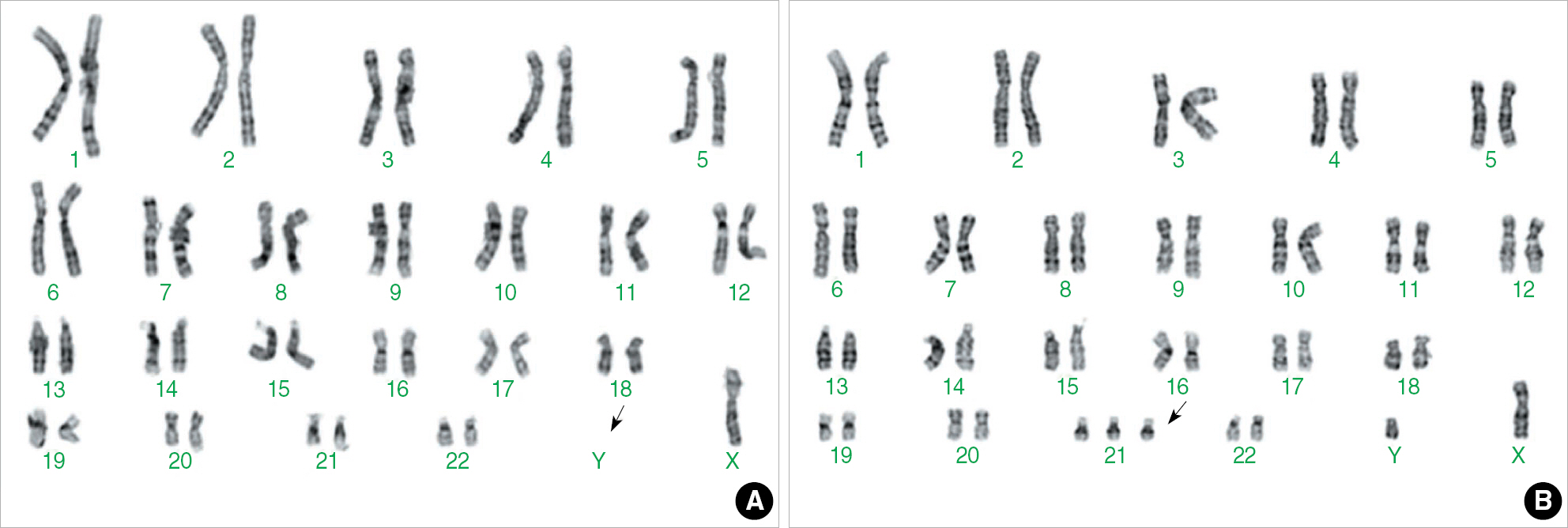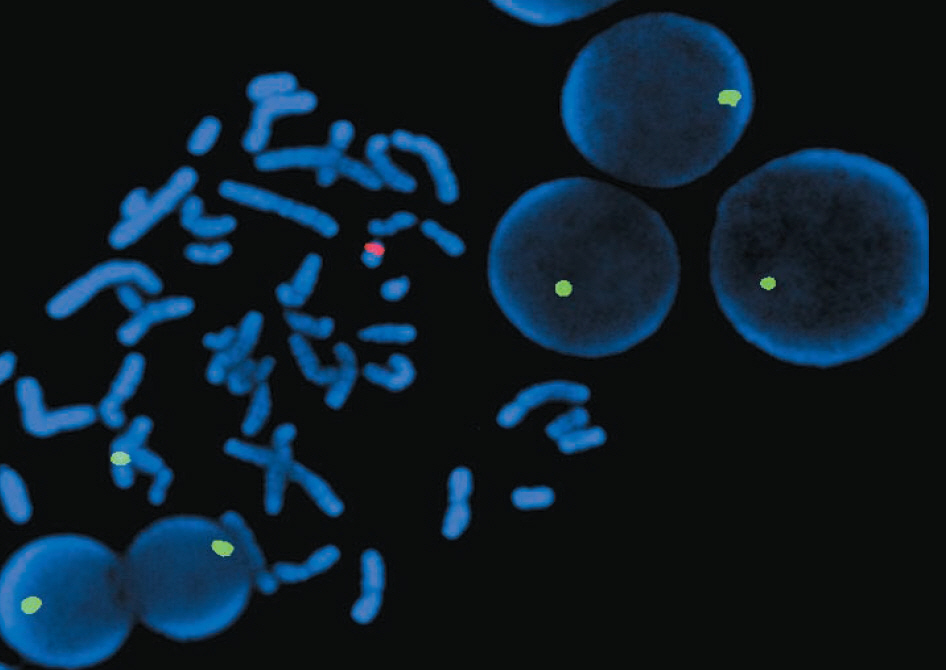Korean J Lab Med.
2010 Apr;30(2):195-200. 10.3343/kjlm.2010.30.2.195.
Down-Turner Syndrome (45,X/47,XY,+21): Case Report and Review
- Affiliations
-
- 1Department of Laboratory Medicine, Kangwon National University School of Medicine, Chuncheon, Korea.
- 2SamKwang Medical Laboratories, Seoul, Korea.
- 3Genetic Laboratory, Fertility Center of CHA Gangnam Medical Center, Seoul, Korea.
- 4Department of Pediatric Allergy & Pneumology, Uijeongbu St. Mary's Hospital, College of Medicine, The Catholic University, Uijeongbu, Korea. kal1119@yuhs.ac
- 5Department of Rehabilitation Medicine, Uijeongbu St. Mary's Hospital, College of Medicine, The Catholic University, Uijeongbu, Korea.
- 6Department of Laboratory Medicine, Yonsei University College of Medicine, Seoul, Korea. kal1119@yuhs.ac
- KMID: 1096808
- DOI: http://doi.org/10.3343/kjlm.2010.30.2.195
Abstract
- We report the case of a 3-yr-old boy with Down-Turner mosaicism and review the previous reports of Down-Turner syndrome with documented karyotyping and clinical features. The patient showed clinical features of Down syndrome without significant stigma of Turner syndrome. Cytogenetic analysis of peripheral blood preparations by using G-banding revealed mosaicism with 2 cell lines (45,X[29]/47,XY,+21[4]). FISH analysis revealed that 87.5% of the cells had monosomy X karyotype and 12.5% of the cells had XY karyotype; trisomy 21 was only detected in the Y-positive cells. We suggest that additional cells should be analyzed and molecular genetic studies should be conducted to rule out double aneuploidy when karyotypes with sex chromosome aneuploidies and mosaicism are encountered, as in our case of Down syndrome mosaic with sex chromosome aneuploidy.
Keyword
MeSH Terms
Figure
Reference
-
1.Kovaleva NV., Mutton DE. Epidemiology of double aneuploidies involving chromosome 21 and the sex chromosomes. Am J Med Genet A. 2005. 134A:24–32.
Article2.Lorda-Sanchez I., Petersen MB., Binkert F., Maechler M., Schmid W., Adelsberger PA, et al. A 48,XXY,+21 Down syndrome patient with additional paternal X and maternal 21. Hum Genet. 1991. 87:54–6.
Article3.Karaman A., Kabalar E. Double aneuploidy in a Turkish child: Down-Klinefelter syndrome. Congenit Anom (Kyoto). 2008. 48:45–7.
Article4.Ford CE., Jones KW., Miller OJ., Mittwoch U., Penrose LS., Ridler M, et al. The chromosomes in a patient showing both mongolism and the Klinefelter syndrome. Lancet. 1959. 1:709–10.
Article5.Hou JW., Wang TR. Double aneuploidy with Down's-Klinefelter's syndrome. J Formos Med Assoc. 1996. 95:350–2.6.Akbas E., Soylemez F., Savasoglu K., Halliogluand O., Balci S. A male case with double aneuploidy (48,XXY,+21). Genet Couns. 2008. 19:59–63.7.Jaruratanasirikul S., Jinorose U. An infant with Down-Turner double aneuploidy: a case report and literature review. J Med Assoc Thai. 1995. 78:108–12.8.Van Buggenhout GJ., Hamel BC., Trommelen JC., Mieloo H., Smeets DF. Down-Turner syndrome: case report and review. J Med Genet. 1994. 31:807–10.
Article9.Zaki MS., Kamel AA., El-Ruby M. Double aneuploidy in three Egyptian patients: Down-Turner and Down-Klinefelter syndromes. Genet Couns. 2005. 16:393–402.10.Jeanty C., Turner C. Prenatal diagnosis of double aneuploidy, 48,XXY,+21, and review of the literature. J Ultrasound Med. 2009. 28:673–81.
Article11.Sparagana M., Wong PW., Dorsch TR., Casten C., Rauer M., Szego K. 45,X/46,XY/47,XY,+21 mosaicism in a hypogonadal phenotypic male. J Med Genet. 1980. 17:319–21.12.Jeong HJ., Lee ES., Choi KH., Park YH. A case of Down-Turner syndrome. J Korean Soc Pediatr Endocrinol. 2005. 10:120–4. (정희정, 이은실, 최광해, 박용훈. 다운-터너 증후군 1례. 대한소아내분비학회지 2005;10:120-4.).13.Musarella MA., Verma RS. An infant with Turner-Down aneuploidy and massive capillary hemangioma of the orbit: a case report with review. Ann Genet. 2001. 44:67–70.
Article14.Ruangdaraganon N., Kotchabhakdi N., Mekanandha V. Double aneuploidy: 46,X,+21 a combination of Down syndrome and Turner syndrome. J Med Assoc Thai. 1993. 76(S2):215–7.15.Osborne RA., Hennigar GR., Barnett CD. Mosaic double aneuploidy of X and G chromosomes. Am J Ment Defic. 1975. 79:644–7.16.Harada N., Abe K., Nishimura T., Sasaki K., Ishikawa M., Fujimoto M, et al. Origin and mechanism of formation of 45,X/47,XX,+21 mosaicism in a fetus. Am J Med Genet. 1998. 75:432–7.
Article17.Townes PL., White MR., Stiffler SJ., Goh K. Double aneuploidy. Turner-Down syndrome. Am J Dis Child. 1975. 129:1062–5.18.Knudtzon J., Aarskog D. 45,X/46,XY mosaicism. A clinical review and report of ten cases. Eur J Pediatr. 1987. 146:266–71.19.Costa T., Lambert M., Teshima I., Ray PN., Richer CL., Dallaire L. Monozygotic twins with 45,X/46,XY mosaicism discordant for phenotypic sex. Am J Med Genet. 1998. 75:40–4.
Article20.Arbuzova S., Cuckle H., Mueller R., Sehmi I. Familial Down syndrome: evidence supporting cytoplasmic inheritance. Clin Genet. 2001. 60:456–62.
Article21.Mutton D., Alberman E., Hook EB. Cytogenetic and epidemiological findings in Down syndrome, England and Wales 1989 to 1993. National Down Syndrome Cytogenetic Register and the Association of Clinical Cytogeneticists. J Med Genet. 1996. 33:387–94.
Article22.Alfi OS., Chang R., Azen SP. Evidence for genetic control of nondisjunction in man. Am J Hum Genet. 1980. 32:477–83.23.Tseng LH., Chuang SM., Lee TY., Ko TM. Recurrent Down's syndrome due to maternal ovarian trisomy 21 mosaicism. Arch Gynecol Obstet. 1994. 255:213–6.
Article
- Full Text Links
- Actions
-
Cited
- CITED
-
- Close
- Share
- Similar articles
-
- A Case of Ovarian Mature Cystic Teratoma in Woman with Turner syndrome
- Detection of Y Mosaicism in Blood and Gonad of Patients with Gonadal Dysgenesis
- A Case of Down-Turner Syndrome
- Primary Amenorrhea in a Woman with 45, XO/46, XX/47, XXX Mosaicism A Case Report
- A Cytogenetic Study in Patients with Suspected Y Chromosomal Abnormalities




